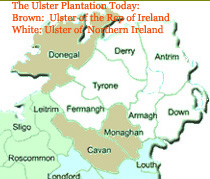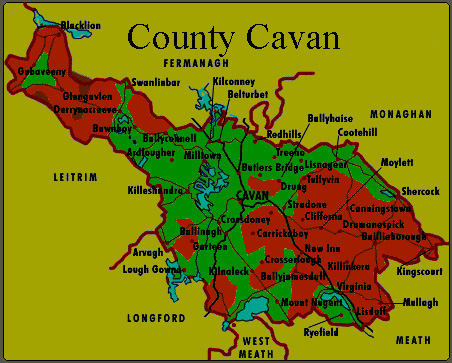Ireland : County Cavan and Bailieborough Within It
Email Webmistress**Copyright and Terms of Use**Vol I: Our American Immigrants
 |
aaaa
Surnames of County Cavan: Williamson , McNeill
, Booker , Hogg, Byers
|
Glasraighe
Ballymachugh is one of the three parishes of the diocese situated in
County Cavan. It lies along Lough Sheelin and in it the Diocese (Ardagh
and Clonmacnoise) reaches its most easterly point about half a mile from
Mountnugent. After the definite establishment of the Diocese of the Ui
Briuin, or Kilmore, this parish remained attached to Ardagh because it
was part of the old principality of Cairbre Gabhra centred at Granard.
This ancient authorities generally speak of Lough Sheelin as in Cairbre;
so the book of Lecan, Leobor Gabhala, Book of Leinster. Earlier than the
time of Cairbre, son of Niall, these lands bordering Lough Sheelin on the
north were inhabited by the pre-Celtic Glasraighe, who were subdued by
him; and for whom long afterwards, the genealogists traced a royal descent
from Cairbre himself.
Source: http://www.cavannet.ie/parishes/ballymac/history/mcnamee.htm
Our Irish immigrant Sarah Williamson was born 1888 in Virginia, Killinkere, Cavan, Ireland, and the associated families of BOOKER, HOGG and BYERS are suspected with antecedants in the county, although direct ancestor Isabella McNEILL , currently the only known of her line, appears to have been born about 1823 in Aghalee, Co Antrim , Northern Ireland (she married her Williamson groom at Corglass Presbyterian, outside Bailieborough in County Cavan, suggesting her as yet unidentified birth family may have emmigrated to that County). Currently, our earliest known ancestor of any surname in County Cavan is Samuel Williamson , born 1769. He is listed 1706 as a flax grower and just a bit later in Tenants of the Manor of Bailieborough relevant to Corlurgan , when he would have been about 36 years old. Our last direct line resident of the County was his GG Grandaughter Sarah Williamson above mentioned, who emmigrated to the US via Ellis Island in 1917.
The parishes of Killinkere and Bailieborough, situated near the eastern
edge of County Cavan, pertain to the region of Sarah Williamsons birth
and here is evidence of her direct lines found via Protestant record.Archeological
evidence of habitation in the region spans back 5000 years, and many of
the ancient Irish lived on artificial islands or 'crannogs', exhibiting
great accomodation to the climate and terrain allowing them to flourish.
Conversion to Christianity by missionaries in the region occured in the
6th century. It seems indisputable that our lines of Cavan are involved
in the Ulster Plantation of ca 1607-1700 long after its formal initiation
in 1610 following the
Nine Years War (1594-1603) . It appears too, that they were not involved
in the Cromwellian Settlement intitated in 1649. Evidence is first
discovered in the period of the Williamite Plantation (started
1694 and lasted 30 years), and the Williamsons are first noted in the land
records there in 1696.
The region of our forebears in the eastern aspect of County Cavan
is relevant to the ancient Irish Clan O'Reilly, rulers of Breffni
, whose last chieftain, Annadh, died in 1220 1.
Another clan with strong association in the now county were the O'Rourkes,
who controlled the territory lying roughly south of Lough Erne1
with whom, during the 13th century, the O'Reillys experienced wars for
territorial control. Prior to the arrival of any of our
known ancestors of the region, and in the later Middle Ages (1200-1600),
Cavan was a border area remaining under the control of Irish chieftains
( though Anglo-Normans had settled to its west and south they were unsuccesful
in their attempt to conquer it). The chief of the Oí Reilly
clan took an oath of allegiance to England's Henry VIII in 1541 and in
1579 County Cavan took on its present boundaries but during the
Nine Years War [AKA Tyrone's Rebellion] (1594-1603)
the O'Reilly's succombed to Clan O Neill persistance and stregnth and so
ultimately joined in rebellion against the English crown, for which
act they lost their independance and saw confiscation of their lands via
the plantation of Ulster. Thus,
in the early 17th century, Cavan was settled by planters from England and
Scotland who laid the foundations for many of the county's town and villages,
including Belturbet, Killeshandra and Virginia 1 and
as a result we find ourselves studying our lines and the history of
the region. far post the influence of Our Ancient Irish direct to this
study, likewise studied in these pages.
In 1610, William Bailie, a Scot, recieved the grant of land for
the Manor of Bailieborough involving 1, 000 acres of arable land and about
16, 000 acres of Bog at Tandragee in the Barony of Clankee, County Cavan.
In accordance with the grant, Bailie enclosed a demesne of 350 acres upon
which he created a fortification and built a castle; By mandate of the
grant to his estate, , he was required to settle upon it a number
of families of English and Scottish extraction and to establish fairs,
marts, and also courts for the administration of the law. By 1629 there
were 29 British families on the manor. Their houses were made of
wood and covered with straw thatch.
In 1641 a siege of the Protestant population by clan Oí Reilly clan
ended with the clan's agreed to retreat to Drogheda.
In 1649, the Puritan Zealot Cromwell and his army descended
on Ireland, having in 1641 made clear his intent to deny mercy to Catholics,
but not limiting his fury to that religion. "His campaign was savage
and is remembered for the slaughter of women and children as well as unarmed
captives. He captured Drogheda and slaughtered the garrison....The Puritan
Parliamentarians persecuted not only Catholics but Ulster Presbyterians,
members of the Church of Ireland and those of other minority religions.
The act for settling Ireland was passed by the English parliament in August
1652. While the land was being surveyed the government was deciding who
should forfeit land. Degrees of guilt were established and penalties defined.
The result was that owners of Irish land, whether they were Catholic, Protestant
or Old English were to suffer. Some were dispossessed totally; others forfeited
one fifth, one third, two thirds or three quarters of their land depending
on whether their part in the rebellion was a major or minor one." " 2
Via the Cromwellian Settlement of 1654 , plans for the settlement of
County Cavan were laid, and all Irish were to be removed by June of 1656.
The Williamite Plantation, initiated in 1691 and continueing for 30 years,
saw Presbyterianism congregations stregnthened . In the late 17th
the village associated with the desmene of the Manor was destroyed, and
a new town, Bailieborough, erected. 1714 brought the building of the Presbyterian
church of Corglass outside Bailieborough. By 1805 our Samuel Williamson
clearly resided on the manor. He saw the town of Bailieborough grow and
assume its modern shape with the estate's acquisition by Colonel
William Young in 1814 , a courthouse and new Market House being erected.
[See The History
of Bailieborough from which much of Bailie and the town''s history
is taken].
In the 18th century, Cavan's English and Scot planter descendants
built fine houses, many of which are still standing and "In October
1824, history was made in the Bailiebourough district when Samuel Williamson
and his son , John, rode out to the castle and got leases, renewable forever,
from Sir William Young, for their town houses and town parks. This was
the first time a Bailieborough landlord granted leases revewable forever,
and it must have been a relief for the leasees to know that, at long last,
they could not be evicted from their holdings at the whim of a landlord
or his agent....Both Samuel and John Williamson took an interest in the
welfare of the district." [Williamson Family Papers from William G. Coleman,
descendant of Ireland] .
County Cavan's countryside "prospered with the growth of the
linen industry. The population grew dramatically, and in 1841 it was nearly
a quarter of a million people - over four times the current population.
At this time over half the population depended entirely on potatoes for
food. When the potato crop failed for two successive years in 1845 and
1846, there was widespread starvation and hardship. Following the Famine,
Cavan became mostly rural, and while it had many lively market towns
and villages, there was very little industry. Many people emigrated in
search of work to America, Canada, Australia and New Zealand...."
1
A Williamson gddtr of Samuel married Isaac Broome, donator of
land for Bailieborough's Presbyterian Trinity Church, opened for worship
in 1887. Probably as a result of the famine, her brother James left for
California. It was not until 1917 that Sarah looked for the last time upon
County Cavan, deciding unmarried and at age 28, to seek her fortune
across the water. It was in Manhattan that she met her husband.
it is in the 17th century, with the plantation of Ulster , that we can
find the historical context for our ancestor's residence in the region
of Bailieborough.
"In the early 17th century, Cavan was settled by planters from England
and Scotland who laid the foundations for many of the county's town and
villages, including Belturbet, Killeshandra and Virginia. In the next century,
their descendants built fine houses, many of which are still standing....
The countryside prospered with the growth of the linen industry. The
population grew dramatically, and in 1841 it was nearly a quarter of a
million people - over four times the current population. At this time over
half the population depended entirely on potatoes for food. When the potato
crop failed for two successive years in 1845 and 1846, there was widespread
starvation and hardship. Following the Famine, Cavan became mostly rural,
and while it had many lively market towns and villages, there was
very little industry. Many people emigrated in search of work to America,
Canada, Australia and New Zealand...." 1
University of ulster Bibilographic Index
The History of Bailieborough, from Bailieborough Community Website
Maps
and Resources (from County Cavan and the McElwains webpages)
Includes links also to a wide variety of useful Cavan links
Cootehill,
Co Cavan Directory 1834
Genuki's Cavan
Links Page [Resource and link page]
County
Cavan Historical/Heritage from goIreland.com
The County Cavan Research
Center Website
Local
History References (From GenWeb)
County
Cavan from Rootsweb
Original
IrelandGenWeb Resource Page and Full Contents for Ireland
County
Cavan Miscellaneous Records Census Substitutes
Genuki's
County Cavan Newspapers Transcription Project
Wills Administrations
and Deeds of Ireland
County Cavan
Gen Web Project
1. County
Cavan from Irish Culture and Customs. com
2. The Cromwellian Settlement by Catherine Oí Donovan


